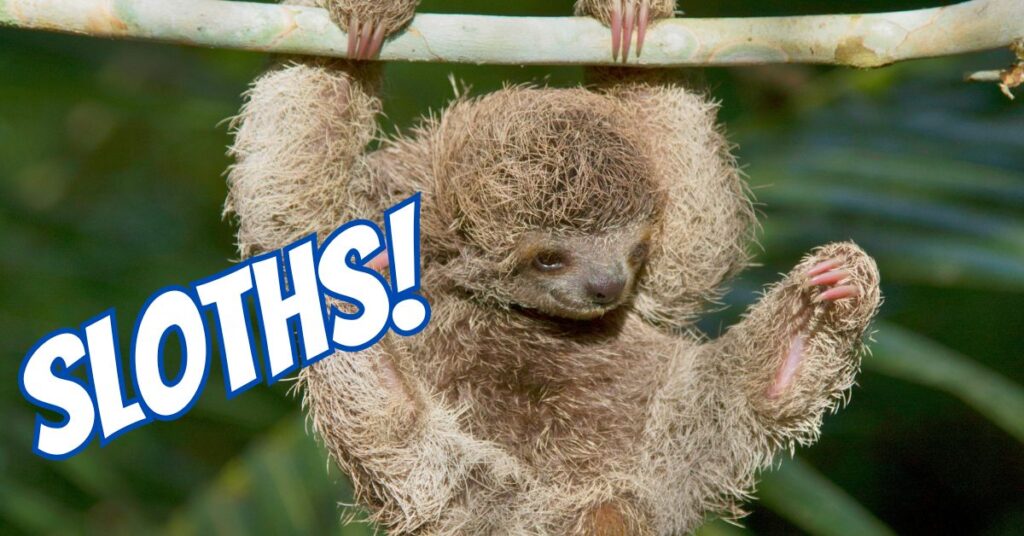
Table of Contents
So you would like to know some fun facts about a sloth? There is so much to learn about these amazing animals. So join me as we dive into the lives of the slow, but fascinating creatures.
Where are Sloths Native to?
Sloths live in Central and South America. Their natural habitat is in the jungles and rainforests. Sloths range from southern Mexico to northern Argentina.
Sloths are arboreal mammals meaning they live in trees. Sloths have long arms and curved claws. These help them hang upside down for hours. Their fur is greenish-brown. This camouflages them in the canopy. Sloths even sleep hanging from branches! Everything about the sloth fits their tree lifestyle.

Deforestation destroys the sloth’s home. Rainforests get cleared for farming and development. This makes some sloth species endangered. Habitat loss threatens the sloth.
When we ask where sloths are native to, we should remember this: Human activity affects where sloths can live. If we want to save sloths, we must protect their jungles and trees.
If you ever visit Central or South America, look for sloths in the treetops. This is the native home of these fascinating animals. Understanding where sloths come from can inspire us. It can make us better stewards of nature.
What do Sloths Eat?
Sloths are slow, deliberate animals. But what do these mellow mammals eat? Sloths have laid-back diets to match their lifestyle.

Sloths live in trees. They eat leaves, fruits, and flowers. Their long claws let them hang upside down. They munch leaves while hanging. Sloths have multi-compartment stomachs. This lets them slowly digest tough plants.
Different sloths eat different things. Brown-throated sloths eat Cecropia leaves. Pale-throated sloths eat figs. Maned sloths cook leaves in the sun. This releases more nutrients. All sloths try to eat the healthiest, easiest leaves to reach.

Sloths don’t drink much water. They only climb down once a week. Instead, sloths get moisture from juicy leaves and fruits. Their green diet provides all they need.
When you see a sloth in a tree, it’s probably dreaming about its next leafy, fruity meal. The answer to “What do sloths eat?” is simple. Sloths eat whatever veggies they can reach from the treetop.
Are Sloths Dangerous?
Sloths seem totally harmless. But are these tree-huggers actually dangerous? Let’s find out.
Sloths aren’t aggressive. But their sharp claws can hurt if they feel threatened. Their curved claws help them climb and hang upside down. One sloth swipe could cause deep cuts.

Sloths can transfer diseases to humans. These include roundworm and leishmaniasis. Touching sloth poop can make you sick. But you’d have to touch wild sloth poop to get these diseases.
Some sloths walk on the forest floor. But they’d rather climb than attack. Even if bothered, a sloth will likely cling to a tree instead of confronting you.
Sloths can harm with claws or diseases. But they are too chill and timid to be truly dangerous. Their conservation status is a bigger threat than any danger to humans.
So sloths are harmless buddies, not hazards. As long as you leave a sloth alone, it will just hang out peacefully. Are sloths dangerous? Nope, they are too relaxed for that!

Are Sloths Endangered?
Sloths look like they don’t have a care. But are these mellow creatures actually at risk? Are sloths endangered?
Many sloth species are threatened in the wild. Forests are destroyed for farming and development. This removes the sloth’s tree home. Other threats like hunting, climate change, and roads also endanger sloths.

The maned three-toed sloth is vulnerable to extinction. The pygmy three-toed sloth is critically endangered. It lives on just one Panamanian island. Other species like Linnaeus’s two-toed sloth are decreasing too as humans take their habitat.
Organizations like the Sloth Conservation Foundation work to protect sloths. They do research, education, and rehabilitation. But there is still much work needed to ensure sloths survive.
Sloths may seem oblivious as they hang out in trees. But many species are threatened. When you see a sloth in a zoo, remember this. Their wild cousins need our help. Are sloths endangered? For sloths, the future looks uncertain.
Why Sloths Are Amazing
Sloths charm us with their smiles and zen nature. But what makes these tree-dwellers so amazing? Let’s find out.
First, sloths are designed for life in trees. Their strong claws let them hang from branches. They even sleep while hanging upside down, how uncomfortable does that sound right? Their greenish fur camouflages them in the canopy. The sloth is built for success.

These mellow animals move super slowly. This helps them avoid predators and survive on leaves. Hanging out and saving energy? Sloths are self-care pros!
Swimming sloths are amazing too. They paddle with their long limbs. Their coarse hair retains water like a wet suit! Sloths are natural swimmers.
Beyond their cool adaptations, sloths are endearing. Their grins and sleepy faces melt our hearts. Watching them slowly nibble leaves is cute overload!
Sloths rock their tree niche. They found success by embracing the slow life. For their zen vibe, sweetness, and abilities, sloths rule. We can all learn from these mellow mammals.
Watch this video for more awesome sloth facts!
The Ultimate Sloth FAQ
Are sloths friendly to humans?
Sloths are generally docile around humans but still wild animals that can be unpredictable.
What does a sloth eat?
Sloths eat mostly leaves, shoots, and fruits from the trees they live in.
Why are sloths in danger?
Sloth populations are declining due to habitat loss and being hit by cars when crossing roads.
Has a sloth ever attacked a human?
There are no verified reports of a sloth attacking a human.
Why can’t humans touch sloths?
Humans shouldn’t touch sloths to avoid stressing them and transferring diseases between species.
Can sloths swim fast?
Sloths are very slow swimmers.
How intelligent are sloths?
Sloths have small brains and are not considered highly intelligent.
Do sloths ever move fast?
Sloths only move fast when in immediate danger, and even then just slightly quicker.
Do sloths have 3 stomachs?
No, sloths have a simple stomach.
Should you hug a sloth?
It’s best not to hug sloths as they are wild animals.
Is it OK to touch a sloth?
It’s not recommended to touch sloths unless trained to handle rescued individuals.
Do sloths carry diseases?
Yes, sloths can transmit diseases to humans through contact.
Will sloths let you pet them?
Sloths will generally not enjoy or allow petting by humans.
Do any animals hunt sloths?
Jaguars, eagles, and snakes hunt sloths.
What does a baby sloth look like?
Baby sloths cling to their mother’s fur for safety and transportation.
What is the highest cause of death for sloths?
Falling from trees due to accidents or attack is the main cause of death.
Do giant sloths exist?
Giant sloths are extinct, having lived over 10,000 years ago.
Do sloths bite hard?
Sloth bites are weak and unlikely to break human skin.
Do sloths lay eggs?
No, sloths give live birth like other mammals.
Are sloths deaf?
Sloths have normal hearing ability.
